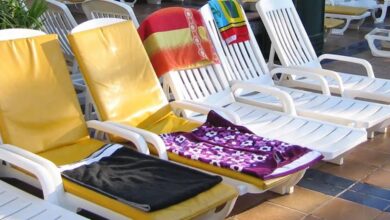Information about Nusantara, the new capital of Indonesia
New capital for Indonesia: "Greenest, most sustainable city in the world"

Indonesia gets a new capital: Nusantara. It aims to be the greenest and most sustainable city in the world. But there are also doubts: The danger to the environment should not be underestimated, say residents.
A blue cube, a gold circular plaque on it, a warning: do not damage, do not remove, otherwise 500 million rupees – or 30,000 euros – penalty. The Titik Nol – translated “zero point”, in German probably the foundation stone – for the new capital of Indonesia. Huge white letters are fixed above the round zero point square: “Titik Nol Nusantara” is there.
The new capital is to be called Nusantara – “archipelago” – just like Indonesia is a huge archipelago with 17,000 islands. Apart from the blue cube and white writing, there is not much to see yet, but the “zero point” is a popular photo motif for the selfie-loving Indonesians, the posing visitors being well guarded by the military and secret service.
reforestation and urban development / New Capital Nusantara
Here in the east of Kalimantan, as the Indonesian part of the huge island of Borneo is called, there are still numerous trees that are being cut down. Loggers transport logs after logs. But it is not a rainforest that has to give way, but eucalyptus plantations.
Sidik Pramono, head of communications for the capital project, explains the big goal. The urban planning envisages that 75 percent of the 256,000 hectares of land should be green: “So it’s not about deforestation at all, but on the contrary about the opportunity to reforest the tropical forest,” he says.
The idea, which should calm all opponents: Nusantara should become the greenest and most sustainable city in the world.
Get out of the juggernaut of Jakarta
The seat of government is supposed to get out of the congested and sinking juggernaut Jakarta. Parts of the current capital are sinking up to 25 centimeters a year, in swampy soil and under their own weight.
President Joko Widodo, known as Jokowi, will only be in office until 2024. Really turning the decades-old idea of a new capital into reality – that’s what he wants to be able to boast about.
Sidik Pramono explains that the preparation phase is now concentrating on the basic infrastructure for logistical access. Construction of the office building in the government center should start in August. And they are working on a dam for the water supply. Water supply is particularly important – especially after the shortage in Jakarta, where illegal water abstraction is causing the city to sink further.
Site Manager Irene Lucas is standing at the gigantic construction site for the Sepaku Semoi Dam. It is dredged, excavated, secured – at a brisk pace. “Our goal is for the dam to be ready by September. September next year? This year! Crazy, isn’t it?” she asks.
Nusantara: Trees for the green city
The dam should be full by the end of 2023. In the meantime, not far from the construction site, what the roots will yield will be planted: in the Persemaian Mentawir, the Mentawir tree nursery. Perched high in the green hills with a pleasant climate, Mohammad Yussuf watches over the future splendor of the world’s most sustainable city.
Yussuf says: “There will be two million seedlings this year. We grow them here and then they can be planted on the site of the new capital. They are all species that are native to Kalimantan.”
Some of the trees can be up to a hundred years old; The future giant trees are still only knee-high, and the site for the tree nursery is still being expanded – with infrastructure such as laboratories, a house of prayer, accommodation for the gardeners, so that the 20 million young trees required per year can be grown.
However, there is already a helipad. Because not only politicians come by to push the project forward, but also financiers for the mega-project. In August, says Yussuf, Jokowi will be on his next trip with Arab visitors – potential investors.
Consequences for wildlife
Parts of the project – the basic infrastructure, for example – will be financed from the state budget, explains Pramono. But that is clearly not a burden, but an investment. And that is then used to attract investors. He allays concerns that China – like in many other countries in Southeast Asia – will gain power through large-scale plants. There are framework conditions that must be met.
For many, the step here is clearly an investment in the future that promises a lot. Others express more concern. Ibu Renie is from the Orangutan Foundation International, a foundation that has been working in this part of Borneo for many decades. She says the capital’s relocation will definitely have an impact on the environment, especially for orangutans and other wildlife:
“They will lose the forest as their habitat and the space for them to move will be restricted, their forage trees will be lost, they will find less food.”
Because even if Nusantara becomes a green city, the trees that orangutans need will not grow there. And even when planning includes corridors and barriers, it’s hard to tell wild animals how to move. So there should definitely be wildlife rescue teams in the new capital that are ready to go at all times.
Renie says: “Because that’s what this concept of the Forest City also means. The city is connected to nature, it wants to protect animals and natural resources – that’s why orangutans and other wild animals must not be endangered at any time.”
“Ten-minute city” of short distances
Forest city, forest city, smart city, green city, most sustainable city – Nusantara has many titles. And there’s another one: An important aspect of sustainability is the idea of the “ten-minute city,” explains Dyah Fatma, one of the consulting architects in the first planning phase.
She explains: “Our goal is for all residents to be able to reach their most important points of contact within five to ten minutes.” So you should be able to get to work, school, the supermarket or the doctor quickly by bike or on foot. “And we try to build the development densely enough that public transport covers everything.”
Fatma is proud to be part of this project. But her colleague Tiyok also expresses doubts: “It’s already a fragile ecosystem if you look at it from an environmental perspective, so you can’t just declare your intention and start building.”
Nusantara should be finished by 2045, and two million people should then have a new home – in the most sustainable city in the world.
Tiyok says it is a landmark project for Indonesia that could lead the country to greatness or ruin. It could prove that Indonesia is serious about sustainability. Or just carry on as usual. Indonesia’s new capital is an opportunity – and a threat.
Ambassador: Putin wants to attend G20 summit in Indonesia
Indonesia: Mount Merapi volcano spews lava and ash – hundreds flee



